- Reclamation
- California-Great Basin
- Area Offices
- CCAO
- Field Offices
- New Melones
- Planning Your Visit
- Wildlife
Wildlife
The environment of New Melones Project consists of plant and animal communities ranging from open water, riparian, and oak woodland communities to conifer stands in the upper canyons. Consequently, there is a broad range of wildlife present including mule deer, gray fox, California quail, red-tail hawks, golden and bald eagles, osprey, 12 species of fish, and a variety of bats. Tiger salamanders, toads, and fairy shrimp can be found in the isolated vernal pools.
The Peoria Wildlife Management Area (PWMA) covers approximately 2,500 acres (1,100 ha) and is located on the southwest side of New Melones Lake. It was purchased specifically as mitigation for wildlife habitat loss as a result of construction of the New Melones Dam and Reservoir. PWMA provides natural habitat for many species of native plants, amphibians, reptiles, birds and mammals, including species listed as threatened, endangered, or species of special concern. There is no motorized access into the area; however, it is used for hiking, sightseeing, wildlife viewing, rock climbing, mountain biking, horseback riding, and hunting (as regulated by the California Department of Fish and Game).
Please treat all animals you may encounter as WILD! Whether a squirrel in your campsite, a deer grazing along the roadside, or a rattlesnake sunning on a rock, keep in mind they can react unpredictably to your presence. Keep a safe distance and do not feed them. Some wild animals such as the squirrel can carry disease, while others such as the deer can cause injury in collisions with cars. Although rare, a few animals such as the rattlesnake can be harmful if medical care is not immediately sought. Also keep in mind that your pet should not come into contact with wildlife. Keeping your pet on a leash, whether in the campground, or on a hiking trail, will keep it and the wild animals in the area trouble free.
These are just a few of the many wildlife species a visitor may see in and around New Melones Lake.
American Bald Eagle
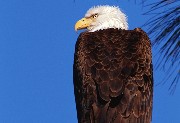 Our nation's symbol for freedom, the bald eagle can be seen along the shoreline looking for fish. These birds use New Melones Lake primarily during the winter, although some are occasionally seen during the summer. Two pairs of nesting bald eagles have been seen recently on New Melones Lake. Once in decline, the species has made a substantial comeback. They are very easy to distinguish when in flight because of their large size (their wingspan can reach eight feet (2 m) across). Adult head and tail feathers are white, and wing feathers dark brown to black. While catching fish provides them with a large part of their diet, they are also “opportunistic scavengers” eating previously killed carcasses. Bald eagle nests can reach up to 15 feet (5 m) across, and weigh as much as two tons or 2,400 pounds (1,000 kg).
Our nation's symbol for freedom, the bald eagle can be seen along the shoreline looking for fish. These birds use New Melones Lake primarily during the winter, although some are occasionally seen during the summer. Two pairs of nesting bald eagles have been seen recently on New Melones Lake. Once in decline, the species has made a substantial comeback. They are very easy to distinguish when in flight because of their large size (their wingspan can reach eight feet (2 m) across). Adult head and tail feathers are white, and wing feathers dark brown to black. While catching fish provides them with a large part of their diet, they are also “opportunistic scavengers” eating previously killed carcasses. Bald eagle nests can reach up to 15 feet (5 m) across, and weigh as much as two tons or 2,400 pounds (1,000 kg).
Barn Owl
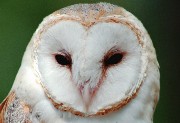 The heart shaped, white-disked face of the barn owl makes this owl distinguishable from other owls. Their wings are of mottled rust to dark brown colors, with creamy-white feathers on the underside. These are common year-round residents of the Sierra Nevada foothills. You may see them flying overhead at dusk or perched on telephone wires. They eat small rodents, snakes, lizards and on occasion frogs and fish. Barn owls have generally adapted to the changes in the landscape, capable of nesting in artificial boxes or old buildings.
The heart shaped, white-disked face of the barn owl makes this owl distinguishable from other owls. Their wings are of mottled rust to dark brown colors, with creamy-white feathers on the underside. These are common year-round residents of the Sierra Nevada foothills. You may see them flying overhead at dusk or perched on telephone wires. They eat small rodents, snakes, lizards and on occasion frogs and fish. Barn owls have generally adapted to the changes in the landscape, capable of nesting in artificial boxes or old buildings.
Great Horned Owl
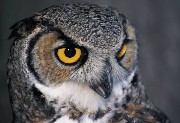 Great horned owls are the most common and largest species in the area. Their body length can be up to three feet (0.3 m) in length with a wingspan up to five feet (1.5 m). They can be identified by their distinct ear "tufts." These owls, like others, hunt primarily at night, although during the winter may occasionally be seen during the day. Great horned owls eat small mammals including rabbits, insects, fish, amphibians, reptiles, and other birds. Because it can live in a variety of habitats, it is the most widely distributed owl in North America.
Great horned owls are the most common and largest species in the area. Their body length can be up to three feet (0.3 m) in length with a wingspan up to five feet (1.5 m). They can be identified by their distinct ear "tufts." These owls, like others, hunt primarily at night, although during the winter may occasionally be seen during the day. Great horned owls eat small mammals including rabbits, insects, fish, amphibians, reptiles, and other birds. Because it can live in a variety of habitats, it is the most widely distributed owl in North America.
Osprey
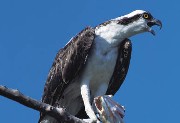 During the summer, visitors to New Melones Lake will often see osprey flying overhead or perched atop nests at the tip of a snag along the shoreline. The underside of the osprey is primarily white, with white head feathers except a dark eye line. Osprey's feet are uniquely designed for catching fish; two toes extend forward, two backward, and the soles are heavily scaled to help clamp tightly onto slippery fish, which make up to 98% of the diet! They are capable of carrying fish weighing up to two pounds (0.9 kg). Manmade nesting platforms have been successfully constructed on many reservoirs in the Sierra Nevada foothills including New Melones Lake.
During the summer, visitors to New Melones Lake will often see osprey flying overhead or perched atop nests at the tip of a snag along the shoreline. The underside of the osprey is primarily white, with white head feathers except a dark eye line. Osprey's feet are uniquely designed for catching fish; two toes extend forward, two backward, and the soles are heavily scaled to help clamp tightly onto slippery fish, which make up to 98% of the diet! They are capable of carrying fish weighing up to two pounds (0.9 kg). Manmade nesting platforms have been successfully constructed on many reservoirs in the Sierra Nevada foothills including New Melones Lake.
Mule Deer
 The mule deer is the most familiar of the large mammals in the Sierra Nevada foothills. These deer are distinguished from other deer in California by their large mule-like ears. Unlike "horned" animals such as bison, male deer will loose their antlers in early winter, and then re-grow them in early summer. By mid-summer, bucks will rub the velvet material off to display the hardened antlers. Deer are plant eaters, varying their diet throughout the year. They eat grasses, leaves, twigs, mushrooms, and during the fall acorns. In higher mountains where there may be deep snows, deer may subsist on lichen and the needles of pine and fir trees. Mule deer graze mostly in the morning and evening hours, bedding down in the middle of the day to avoid the higher daytime temperatures. When viewing these and any wild animal, keep a safe distance. While these animals are often seen as harmless and gentle, they have been known to panic and kick with their sharp front hooves. Bucks, especially during the mating season, may also become aggressive and lunge with their sharp antler rack. Their main predator is the mountain lion, although coyotes and bobcats may kill fawns. Disease and collisions with motor vehicles also take a high toll on deer.
The mule deer is the most familiar of the large mammals in the Sierra Nevada foothills. These deer are distinguished from other deer in California by their large mule-like ears. Unlike "horned" animals such as bison, male deer will loose their antlers in early winter, and then re-grow them in early summer. By mid-summer, bucks will rub the velvet material off to display the hardened antlers. Deer are plant eaters, varying their diet throughout the year. They eat grasses, leaves, twigs, mushrooms, and during the fall acorns. In higher mountains where there may be deep snows, deer may subsist on lichen and the needles of pine and fir trees. Mule deer graze mostly in the morning and evening hours, bedding down in the middle of the day to avoid the higher daytime temperatures. When viewing these and any wild animal, keep a safe distance. While these animals are often seen as harmless and gentle, they have been known to panic and kick with their sharp front hooves. Bucks, especially during the mating season, may also become aggressive and lunge with their sharp antler rack. Their main predator is the mountain lion, although coyotes and bobcats may kill fawns. Disease and collisions with motor vehicles also take a high toll on deer.
Coyote
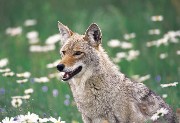 Coyotes are highly adaptable animals that inhabit the New Melones area. Although fairly common, because they hunt mostly at night, they are rarely seen. Their diet ranges from small rodents such as mice, rabbits and squirrels to frogs, small snakes birds and insects. They will also eat grasses and berries when in season. Generally, these animals avoid areas where people reside, although on occasion you may see one cross a road or hear them howl off in the distance at night.
Coyotes are highly adaptable animals that inhabit the New Melones area. Although fairly common, because they hunt mostly at night, they are rarely seen. Their diet ranges from small rodents such as mice, rabbits and squirrels to frogs, small snakes birds and insects. They will also eat grasses and berries when in season. Generally, these animals avoid areas where people reside, although on occasion you may see one cross a road or hear them howl off in the distance at night.
Mountain Lion
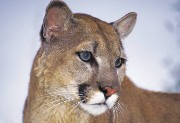 Mountain lions are the largest and most powerful predators found in the Sierra Nevada foothills. They have large ranges and will follow the migratory pattern of their prey, the mule deer. In recent years, mountain lions have been spotted adjacent to trails and developed areas of New Melones Lake. These cats prefer cliffs, rocky ledges and ridge tops where they can watch for prey. Their light tan color enables them to remain concealed until they are very close to their prey. They play an important role in the maintenance of healthy deer populations by killing diseased or injured animals.
Mountain lions are the largest and most powerful predators found in the Sierra Nevada foothills. They have large ranges and will follow the migratory pattern of their prey, the mule deer. In recent years, mountain lions have been spotted adjacent to trails and developed areas of New Melones Lake. These cats prefer cliffs, rocky ledges and ridge tops where they can watch for prey. Their light tan color enables them to remain concealed until they are very close to their prey. They play an important role in the maintenance of healthy deer populations by killing diseased or injured animals.
ADVISORY: Attacks by mountain lions in California are rare, but can occur. Precautions that can be taken include:
- Know where you are hiking, bicycling or jogging by checking out the latest advisories posted.
- Go in groups, Most attacks that have occurred involved a single person.
- If confronted by a mountain lion make yourself look as large as possible.
- Fight off any attack aggressively; running away may prompt the predator to be more aggressive.
Ticks
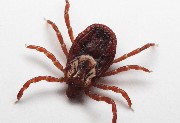 Ticks are small insects often found on deer and domestic animals including livestock. They are most abundant in the early spring and summer. They “embed” or attach themselves to the skin and feed on their host's blood. Because of their small size, they are often not noticed until they have already become embedded, which can be painful. They usually wait in low-lying vegetation or grass and grab onto passing animals or people.
Ticks are small insects often found on deer and domestic animals including livestock. They are most abundant in the early spring and summer. They “embed” or attach themselves to the skin and feed on their host's blood. Because of their small size, they are often not noticed until they have already become embedded, which can be painful. They usually wait in low-lying vegetation or grass and grab onto passing animals or people.
ADVISORY: Ticks have been found in the Sierra Nevada foothills with Lyme disease. When recreating in grassy or bushy areas, you should frequently check the outside of your clothing for ticks. Long pants and store bought repellents can also reduce the likelihood of a tick becoming attached to you. After a hike, check yourself carefully all over, as well as the hair of your pets as ticks may “wander” around before settling onto them.
Western Pacific Rattlesnake
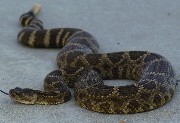 Most species of snake found at New Melones Lake are non-poisonous. The only poisonous snake found here is the Western Pacific Rattlesnake. These rattlesnakes are distinguished by their triangular shaped head, dark brown bands, and rattles at the tip of the tail. They feed on small rodents using heat sensing "pits" near their eyes to locate mice, small rodents and other snakes. On rare occasions, people and/or their pets may encounter a rattlesnake. During the summer, snakes are most active from dusk until dawn. During the daytime, snakes will seek out cooler places, underground in holes, or under rocks. During the middle of winter, snakes will retreat underground and go into a state of hibernation until temperatures warm again.
Most species of snake found at New Melones Lake are non-poisonous. The only poisonous snake found here is the Western Pacific Rattlesnake. These rattlesnakes are distinguished by their triangular shaped head, dark brown bands, and rattles at the tip of the tail. They feed on small rodents using heat sensing "pits" near their eyes to locate mice, small rodents and other snakes. On rare occasions, people and/or their pets may encounter a rattlesnake. During the summer, snakes are most active from dusk until dawn. During the daytime, snakes will seek out cooler places, underground in holes, or under rocks. During the middle of winter, snakes will retreat underground and go into a state of hibernation until temperatures warm again.
ADVISORY: During your visit, watch where you walk, place your hands, and sit. If you see any kind of snake keep your distance. If struck by a rattlesnake, seek immediate medical attention.

